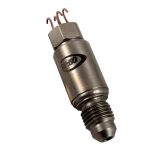 A transducer is an electronic device designed to convert one type of energy into a different type of energy. Non-electrical energy, such as pressure or temperature, can be converted into a quantifiable electrical signal using a transducer.
A transducer is an electronic device designed to convert one type of energy into a different type of energy. Non-electrical energy, such as pressure or temperature, can be converted into a quantifiable electrical signal using a transducer.
Transducers may also be referred to as “transmitters,” with the only functional difference being the type of electrical output; transducer output is measured in voltage, while transmitter output is measured in current. Whether the use of a transducer or a transmitter is appropriate is determined by the overall needs of the intended final application.
Once converted into electronic signal, pressure and temperature measurements can be integrated into software programs that enable report generation, the remote or automated monitoring of environmental conditions, or integration into a larger system of variables.
Transducers are a core functional component across nearly all major industries, including Oil and Gas, Aerospace, and Automotive. They provide the means for fuel regulation, altitude control, and temperature control, among countless other applications.
When deciding what type of pressure transducer to use for a specific application, a number of factors need to be considered. Among these are:
“Differential Pressure” transducers compare the quantity of two separate medias without using a definitive set reference point (such as atmospheric pressure or vacuum). For example, a transducer may act as a filter monitor by comparing the pressure increase caused by contaminant build-up to the pressure level established upon installation. Measurements will be labeled in PSIG.
Hysteresis is defined fairly universally (I say “fairly” because there will ALWAYS be the possibility of exceptions, so it’s important to be aware of that possibility so that any miscommunication between manufacturer and customer are avoided):
As pressure is applied to a sensor, this is referred to as “increasing pressure.” When pressure is removed from a sensor, this is referred to as “decreasing pressure.” Hysteresis is determined by measuring output points at predefined intervals during increasing pressure, and comparing them to output points measured at the same predefined intervals during decreasing pressure. The maximum difference found between the increasing pressure points and the decreasing pressure points is the hysteresis value of the transducer, and is mathematically defined as a percentage of the full-scale output of the sensor.
Repeatability is well-defined as the maximum difference in output when the same pressure is applied, consecutively, under the same conditions and approaching from the same direction.
Pressure transducers are available in 3 types of electrical output; millivolt (mV), amplified voltage, and 4-20mA.
Also known as pressure transmitters, a 4-20mA transducer is least affected by electrical noise and resistance in the signal wires, and is therefore best suited for when a signal must be transmitted long distances. 4-20mA transducers are commonly used in applications where the lead wire must be 1,000 feet or more.
*Most analog signals require some form of preparation before they can be digitized. Signal conditioning is the manipulation of a signal in a way that prepares it for the next stage of processing. Many applications involve environmental or structural measurement, such as temperature and vibration, from sensors. These sensors, in turn, require signal conditioning before a data acquisition device can effectively and accurately measure the signal. For example, thermocouple signals have very small voltage levels that must be amplified before they can be digitized. Other sensors, such as resistance temperature detectors (RTDs), thermistors, strain gages, and accelerometers, require excitation to operate. All of these preparation technologies are forms of signal conditioning.
Email Us or call (877) 774-4751 or (716) 773-9300 (Outside US)
or find your local GP:50 Sales Representative using the links below.
GP50 NY LTD
We firmly believe that the internet should be available and accessible to anyone, and are committed to providing a website that is accessible to the widest possible audience, regardless of circumstance and ability.
To fulfill this, we aim to adhere as strictly as possible to the World Wide Web Consortium’s (W3C) Web Content Accessibility Guidelines 2.1 (WCAG 2.1) at the AA level. These guidelines explain how to make web content accessible to people with a wide array of disabilities. Complying with those guidelines helps us ensure that the website is accessible to all people: blind people, people with motor impairments, visual impairment, cognitive disabilities, and more.
This website utilizes various technologies that are meant to make it as accessible as possible at all times. We utilize an accessibility interface that allows persons with specific disabilities to adjust the website’s UI (user interface) and design it to their personal needs.
Additionally, the website utilizes an AI-based application that runs in the background and optimizes its accessibility level constantly. This application remediates the website’s HTML, adapts Its functionality and behavior for screen-readers used by the blind users, and for keyboard functions used by individuals with motor impairments.
If you’ve found a malfunction or have ideas for improvement, we’ll be happy to hear from you. You can reach out to the website’s operators by using the following email sales@gp50.com.
Our website implements the ARIA attributes (Accessible Rich Internet Applications) technique, alongside various different behavioral changes, to ensure blind users visiting with screen-readers are able to read, comprehend, and enjoy the website’s functions. As soon as a user with a screen-reader enters your site, they immediately receive a prompt to enter the Screen-Reader Profile so they can browse and operate your site effectively. Here’s how our website covers some of the most important screen-reader requirements, alongside console screenshots of code examples:
Screen-reader optimization: we run a background process that learns the website’s components from top to bottom, to ensure ongoing compliance even when updating the website. In this process, we provide screen-readers with meaningful data using the ARIA set of attributes. For example, we provide accurate form labels; descriptions for actionable icons (social media icons, search icons, cart icons, etc.); validation guidance for form inputs; element roles such as buttons, menus, modal dialogues (popups), and others. Additionally, the background process scans all of the website’s images and provides an accurate and meaningful image-object-recognition-based description as an ALT (alternate text) tag for images that are not described. It will also extract texts that are embedded within the image, using an OCR (optical character recognition) technology. To turn on screen-reader adjustments at any time, users need only to press the Alt+1 keyboard combination. Screen-reader users also get automatic announcements to turn the Screen-reader mode on as soon as they enter the website.
These adjustments are compatible with all popular screen readers, including JAWS and NVDA.
Keyboard navigation optimization: The background process also adjusts the website’s HTML, and adds various behaviors using JavaScript code to make the website operable by the keyboard. This includes the ability to navigate the website using the Tab and Shift+Tab keys, operate dropdowns with the arrow keys, close them with Esc, trigger buttons and links using the Enter key, navigate between radio and checkbox elements using the arrow keys, and fill them in with the Spacebar or Enter key.Additionally, keyboard users will find quick-navigation and content-skip menus, available at any time by clicking Alt+1, or as the first elements of the site while navigating with the keyboard. The background process also handles triggered popups by moving the keyboard focus towards them as soon as they appear, and not allow the focus drift outside of it.
Users can also use shortcuts such as “M” (menus), “H” (headings), “F” (forms), “B” (buttons), and “G” (graphics) to jump to specific elements.
We aim to support the widest array of browsers and assistive technologies as possible, so our users can choose the best fitting tools for them, with as few limitations as possible. Therefore, we have worked very hard to be able to support all major systems that comprise over 95% of the user market share including Google Chrome, Mozilla Firefox, Apple Safari, Opera and Microsoft Edge, JAWS and NVDA (screen readers), both for Windows and for MAC users.
Despite our very best efforts to allow anybody to adjust the website to their needs, there may still be pages or sections that are not fully accessible, are in the process of becoming accessible, or are lacking an adequate technological solution to make them accessible. Still, we are continually improving our accessibility, adding, updating and improving its options and features, and developing and adopting new technologies. All this is meant to reach the optimal level of accessibility, following technological advancements. For any assistance, please reach out to sales@gp50.com.
